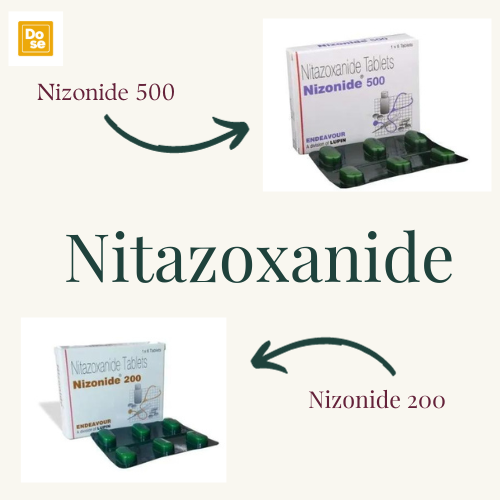Diarrhea is a common gastrointestinal issue characterized by frequent, loose, or watery stools. It can be caused by various factors, including infections, medications, and underlying health conditions. One of the notable treatments for diarrhea caused by parasitic and protozoal infections is nitazoxanide 500 mg. This article explores the role of nitazoxanide in treating diarrhea in adults, its mechanism of action, efficacy, benefits, and potential side effects.
Understanding Nitazoxanide
Nitazoxanide is an antiparasitic and antiviral medication used to treat a variety of gastrointestinal infections. It is particularly effective against protozoal infections, such as Giardia lamblia and Entamoeba histolytica, as well as certain bacterial and viral pathogens. Originally developed as an antiprotozoal agent, nitazoxanide has since been recognized for its broad-spectrum activity against a range of pathogens that cause diarrhea.
Mechanism of Action
Nitazoxanide works through a multifaceted mechanism of action. It interferes with the anaerobic energy metabolism of pathogens by inhibiting the pyruvate-ferredoxin oxidoreductase (PFOR) enzyme system. This enzyme system is crucial for the energy production of certain protozoa and anaerobic bacteria. By disrupting this metabolic pathway, nitazoxanide effectively inhibits the growth and replication of the pathogens responsible for diarrhea.
Additionally, nitazoxanide has been shown to possess some antiviral activity, which contributes to its efficacy in treating viral gastroenteritis. It affects the replication cycle of certain viruses, further expanding its therapeutic potential.
Efficacy in Treating Diarrhea
1. Protozoal Infections
Nitazoxanide is particularly effective against protozoal infections, such as giardiasis and amoebiasis, which are common causes of diarrhea. Giardiasis, caused by Giardia lamblia, can lead to symptoms like abdominal cramps, nausea, and persistent diarrhea. Clinical studies have demonstrated that nitazoxanide is highly effective in treating giardiasis, with cure rates exceeding 90%.
Amoebiasis, caused by Entamoeba histolytica, is another protozoal infection that can result in severe diarrhea and dysentery.nitazoxanide 200 mg has shown significant efficacy in treating amoebiasis, leading to resolution of symptoms and eradication of the infection in many cases.
2. Viral Gastroenteritis
Nitazoxanide also has activity against certain viruses that cause gastroenteritis, including rotavirus and norovirus. Rotavirus is a leading cause of diarrhea in children, but it can also affect adults. Nitazoxanide’s antiviral properties help in reducing the severity and duration of symptoms associated with rotavirus and other viral pathogens.
3. Mixed Infections
In some cases, diarrhea may be caused by a combination of bacterial, protozoal, and viral infections. Nitazoxanide’s broad-spectrum activity makes it a valuable option for treating mixed infections. By targeting various pathogens, nitazoxanide can help manage diarrhea that results from multiple infectious sources.
Administration and Dosage
Nitazoxanide is available in oral tablet and suspension forms. The typical adult dosage for treating infections like giardiasis or amoebiasis is 500 mg twice daily for three days. For viral gastroenteritis, the dosing regimen may vary depending on the specific pathogen and clinical guidelines.
It is essential to adhere to the prescribed dosage and duration of treatment to ensure effectiveness and minimize the risk of resistance. The medication should be taken with food to enhance absorption and reduce potential gastrointestinal side effects.
Benefits of Nitazoxanide
1. Broad-Spectrum Activity
One of the key benefits of nitazoxanide is its broad-spectrum activity against various pathogens. This makes it a versatile treatment option for diarrhea caused by different infectious agents. Its effectiveness against both protozoal and viral pathogens adds to its utility in managing diverse gastrointestinal infections.
2. Rapid Onset of Action
Nitazoxanide generally has a rapid onset of action, with symptom improvement often observed within a few days of starting treatment. This quick response can lead to prompt relief of diarrhea and associated symptoms, enhancing patient comfort and recovery.
3. Well-Tolerated
Nitazoxanide is generally well-tolerated by most patients. Common side effects are usually mild and include nausea, abdominal pain, and headache. Severe adverse reactions are rare, making nitazoxanide a relatively safe option for treating diarrhea caused by infectious agents.
Potential Side Effects
While nitazoxanide is generally well-tolerated, it is important to be aware of potential side effects. Common side effects include:
- Gastrointestinal Symptoms: Nausea, vomiting, and abdominal discomfort are the most frequently reported side effects. These symptoms are usually mild and transient.
- Headache: Some patients may experience headaches during treatment with nitazoxanide.
- Allergic Reactions: Although rare, allergic reactions such as rash, itching, or swelling may occur. Immediate medical attention is required if severe allergic reactions are suspected.
- Liver Function: In rare cases, nitazoxanide may affect liver function. Regular monitoring of liver enzymes is recommended for patients with pre-existing liver conditions.
Considerations and Precautions
1. Pre-existing Health Conditions
Patients with liver or kidney conditions should use nitazoxanide with caution, as these conditions may affect the drug’s metabolism and excretion. It is important to inform the healthcare provider of any pre-existing health conditions before starting treatment.
2. Drug Interactions
Nitazoxanide has minimal interactions with other medications. However, it is essential to inform the healthcare provider of all current medications to avoid potential interactions and ensure safe use.
3. Pregnancy and Breastfeeding
The safety of nitazoxanide during pregnancy and breastfeeding has not been well established. It is recommended to use nitazoxanide only if the potential benefits outweigh the risks, and under the guidance of a healthcare provider.
Conclusion
Nitazoxanide is a valuable medication in the treatment of diarrhea caused by protozoal and viral infections. Its broad-spectrum activity, rapid onset of action, and general tolerability make it an effective option for managing gastrointestinal infections. By targeting various pathogens and providing prompt relief of symptoms, nitazoxanide helps improve patient outcomes and quality of life.
Patients should follow the prescribed dosage and treatment duration to achieve the best results and minimize the risk of side effects. As with any medication, it is important to consult a healthcare provider to determine the appropriate treatment plan based on individual health needs and circumstances. Nitazoxanide continues to play a significant role in addressing diarrhea caused by infectious agents, offering an effective solution for a common and often debilitating condition.










